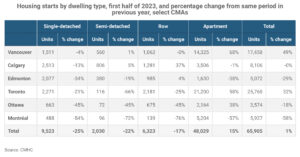
First-half housing starts flat in major Canadian markets
By Adam Freill
Construction ResidentialCMHC tracking sees almost no growth in housing supply across Canada’s largest cities in first six months of 2023.

Housing starts by dwelling type – first half of 2023. (Source: Canada Mortgage and Housing Corporation)
Despite a need for new housing, Canada’s largest cities saw just a one per cent growth in housing supply across the first six months of 2023, compared to the first half of 2022, reports Canada Mortgage and Housing Corporation (CMHC) in the latest edition of Housing Supply Report (HSR). The report examines new housing construction trends in Canada’s six largest Census Metropolitan Areas (CMAs).
Tighter borrowing conditions, elevated construction and labour costs, and high interest rates created challenging conditions for homebuilders across all six major markets. Additionally, construction timelines saw a slight increase from the first half of 2022, up 0.9 months.
Toronto and Vancouver accounted for nearly two-thirds of the housing starts across the six markets, with apartment starts making up nearly three-quarters of all housing construction. The strong apartment growth observed in Toronto and Vancouver was offset by declines in Canada’s other largest centres.
“Given larger building size and resulting longer preparation time of the buildings started in Toronto and Vancouver, the numbers posted in these cities are the result of a process that began at a time when financing and building conditions were considerably more favourable,” stated Kevin Hughes, deputy chief economist for the CMHC. “This contrasts with Montreal, which is more reflective of the current, more challenging, context, such as higher financing and construction costs.”
In September, the Department of Finance announced that the annual limit for Canada Mortgage Bonds is being increased from $40 billion to $60 billion, a move that should signal to builders that they can rely on additional low-cost financing and allow more rental supply projects to move forward.
CMHC’s housing starts data for July and August show a continuation of the overall trend observed in the report as new home construction remained relatively flat at the national level.
In its updated Supply Gaps Estimate (SGE) Report, CMHC indicated that the overall national supply gap remains at approximately 3.5 million more housing units by 2030, over and above what is already projected to be built by that time.




